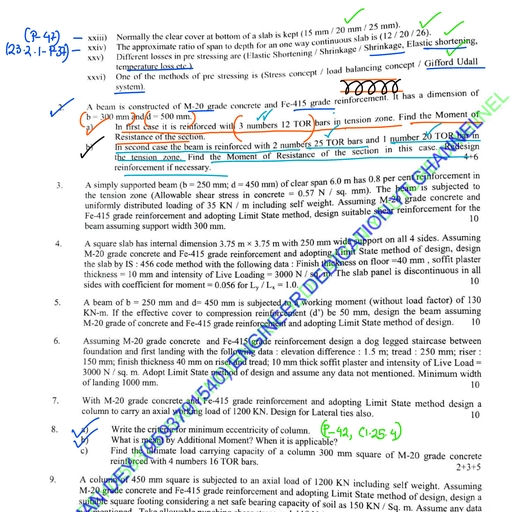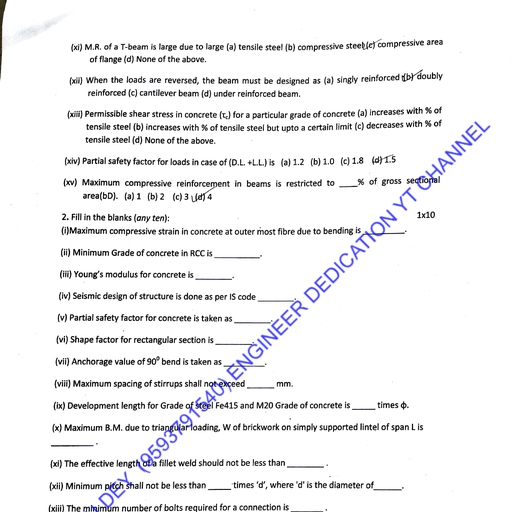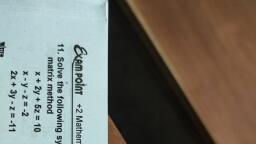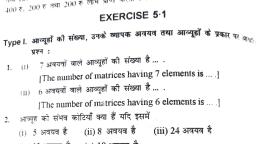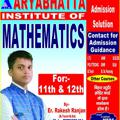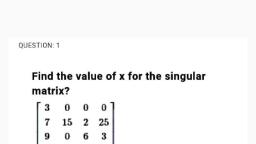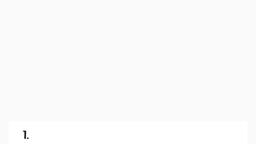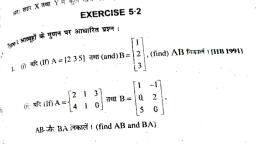Question 1 :
$\displaystyle \begin{vmatrix} 1 & a & {a}^{2}-bc \\ 1 & b & {b}^{2}-ca \\ 1 & c & {c}^{2}-ab \end{vmatrix}$=?
Question 2 :
If $\begin{vmatrix} x-4 & 2x & 2x \\ 2x & x-4 & 2x \\ 2x & 2x & x-4 \end{vmatrix}$ = $(A+Bx)(x-A)^2$,<br>then the ordered pair $(A , B)$ is equal to:
Question 3 :
When a row matrix is multiplied by a column matrix both having the same number of elements, the resulting matrix formed is a ___?
Question 4 :
Let $A = \begin{bmatrix} -2 & 7 & \sqrt{ 3}  \\ 0 & 0 & -2 \\ 0 & 2 & 0 \end{bmatrix} $  and $A^4 = \lambda$. I, then $\lambda $ is
Question 5 :
If the number of elements in a matrix is $60$ then how many different order of matrix are possible 
Question 6 :
If $A = \bigl(\begin{smallmatrix}1 & -2\\ -3 & 4\end{smallmatrix}\bigr)$ and $A + B = O$, then B is<br>
Question 7 :
If $A$ is $2\times 3$ matrix and $AB$ is a $2\times 5$ matrix, then $B$ must be a
Question 8 :
If A =$\begin{bmatrix}1 & 2 \\ 3 & 4 \end{bmatrix}$, B =$\begin{bmatrix}2 & 3 \\ 4 & 5 \end{bmatrix}$, and 4A - 3B + C = 0, then C =
Question 9 :
Consider $A$ and $B$ two square matrices of same order. Select the correct alternative.
Question 10 :
$\left[ \begin{matrix} x \\ 3 \end{matrix}\begin{matrix} 6 \\ 2x \end{matrix} \right]$ is a singular matrix, then $x$ is equal to
Question 11 :
Out of the following matrices, choose that matrix which is a scalar matrix.
Question 12 :
Let $n\ge 2$ be an integer,<br/>$A=\begin{bmatrix} \cos { \left( { \dfrac{2\pi}n} \right)  }  & \sin { \left(\dfrac{2\pi}n \right)  }  & 0 \\ -\sin { \left( \dfrac{2\pi}n \right)  }  & \cos { \left(\dfrac{2\pi}n \right)  }  & 0 \\ 0 & 0 & 1 \end{bmatrix}$ and $I$ is the identity matrix of order $3$., then following of which is correct
Question 13 :
If $A = \bigl(\begin{bmatrix}7 &2 \\ 1 & 3\end{bmatrix}\bigr)$ and $A + B = \bigl(\begin{bmatrix} -1& 0\\ 2 & -4\end{bmatrix}\bigr)$, then the matrix B =<br/>
Question 14 :
Let $C_k =$ $^nC_k$ for $0\leq k\leq n$ and<br>$A_k=\begin{bmatrix}C_{k-1}^2&0 \\0 &C_k^2 \end{bmatrix}$ for $k\geq 1$, and $A_1+A_2+ ... + A_n=\begin{bmatrix}k_1 &0 \\0 &k_2\end{bmatrix}$, then<br>
Question 15 :
If $A = \dfrac {1}{\pi} \begin{bmatrix}\sin^{-1}(\pi x) & \tan^{-1} \left (\dfrac {\pi}{\pi}\right )\\ \sin^{-1} \left (\dfrac {x}{\pi}\right ) &\cot^{-1} (\pi x)\end{bmatrix}, B =\dfrac {1}{\pi} \begin{bmatrix}-\cos^{-1}(\pi x) &\tan^{-1} \left (\dfrac {x}{\pi}\right ) \\ \sin^{-1} \left (\dfrac {x}{\pi}\right ) & -\tan^{-1} (\pi x)\end{bmatrix}$, then $A - B$ is equal to<br/>
Question 16 :
A is of order $m \times n$ and B is of order $p \times q$, addition of A and B is possible only if<br>

